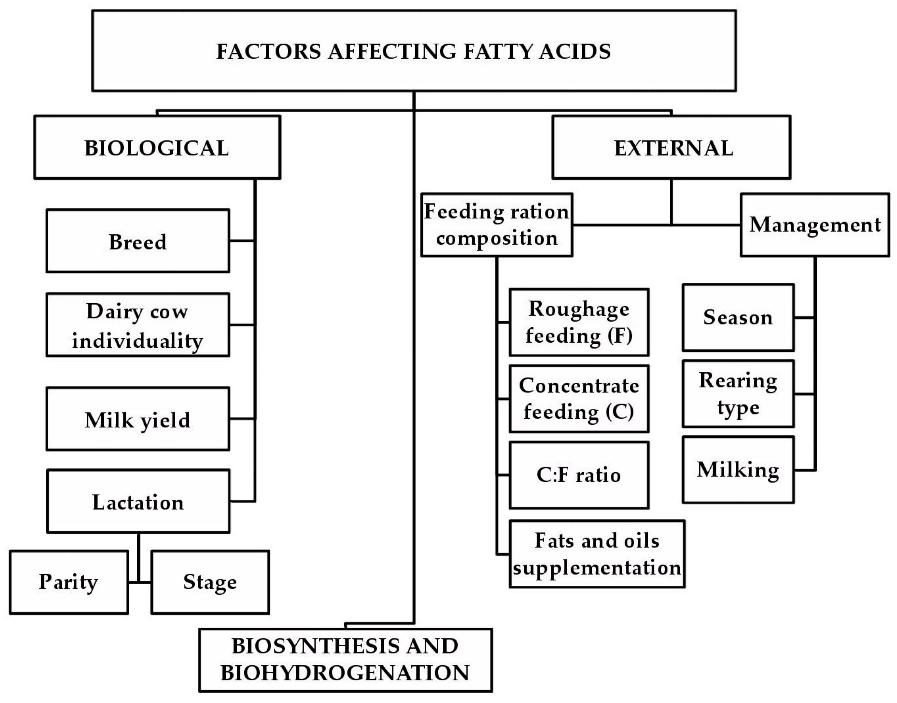Milk fat is a vital nutrient in milk and is highly variable. Milk fat is mainly composed of triglycerides (approximately 98%), which are made up of glycerol and fatty acids. Fatty acids are important nutrients in the human diet and significantly impact human health. Based on the fatty acid profile, a significant contribution can be made to producing dairy products with higher added value. The fatty acid profile is considered an important factor in the technological quality of raw milk. Many factors can alter the fatty acids in milk (Fig. 1). Generally, the fat profile, especially the fatty acid profile, is an indicator of milk nutrition and quality. It is often necessary to test the fat and fatty acid properties of milk to determine its nutritional and economic value. Lifeasible offers services to help detect fats in milk and milk products, including total fat, essential fatty acids, trans fatty acids, and saturated fatty acids. We help customize the analysis of fat and fatty acid properties in milk and milk products. We also offer several other testing services related to milk fat.
 Fig. 1 Diagram of the sources of variability in the fatty acid profile of milk (Hanuš et al., 2018).
Fig. 1 Diagram of the sources of variability in the fatty acid profile of milk (Hanuš et al., 2018).
The total fat in milk is an important indicator for people to buy milk and milk products. We provide professional milk total fat determination services to help determine the fat in milk and milk products. We offer three main methods to help detect total fat in milk. We mainly use the gravimetric method for the total fat of milk products. We implement our services with reference to international standards to ensure that we provide the most professional determination.
Determination of essential fatty acids
Essential fatty acids cannot be synthesized in the human body and must be obtained from external sources. Drinking milk is the main way for modern people to obtain essential fatty acids. It is essential to test the amount of essential fatty acids in milk.
We help detect omega-3 (ω - 3) and omega-6 (ω - 6) family polyunsaturated fatty acids (PUFAs) in milk and milk products, which are the major PUFAs and important essential fatty acids. We use chromatographic methods that meet international standards for detecting essential fatty acids.
Determination of trans fatty acids
Trans fatty acids are closely related to weight control in humans, and excessive intake of trans fatty acids can cause obesity, cardiovascular disease, and diabetes. The detection of trans fatty acids is susceptible to interference from other fatty acids in milk. We help determine trans fatty acids in milk using gas chromatography (GC), mass spectrometry (MS), and infrared spectroscopy (IR) for more accurate determination of trans fatty acids in milk.
Other determination services for milk fat
We help determine other fatty acid types in milk and milk products, including free fatty acids (FFAs), saturated fatty acids (SFAs), monounsaturated fatty acids (MUFAs), polyunsaturated fatty acids (PUFAs), and omega-9 fatty acids. Additionally, we can help detect multiple individual fatty acids, including linoleic acid (LA), alpha-linolenic acid (ALA), arachidonic acid (ARA), eicosapentaenoic acid (EPA), and docosahexaenoic acid (DHA). We can provide customized fat analysis services based on customer needs.
We can help analysis of triacylglycerols and determine specific fats such as sterols. We also help determine the peroxide value of milk fat.
Lifeasible provides professional milk fat testing services. Our comprehensive and customized fat testing and analysis services meet the needs of many clients. Our international level of testing has earned us the trust of many clients. Please contact us for your milk fat testing services.
References
Lifeasible has established a one-stop service platform for plants. In addition to obtaining customized solutions for plant genetic engineering, customers can also conduct follow-up analysis and research on plants through our analysis platform. The analytical services we provide include but are not limited to the following:
July 13, 2024